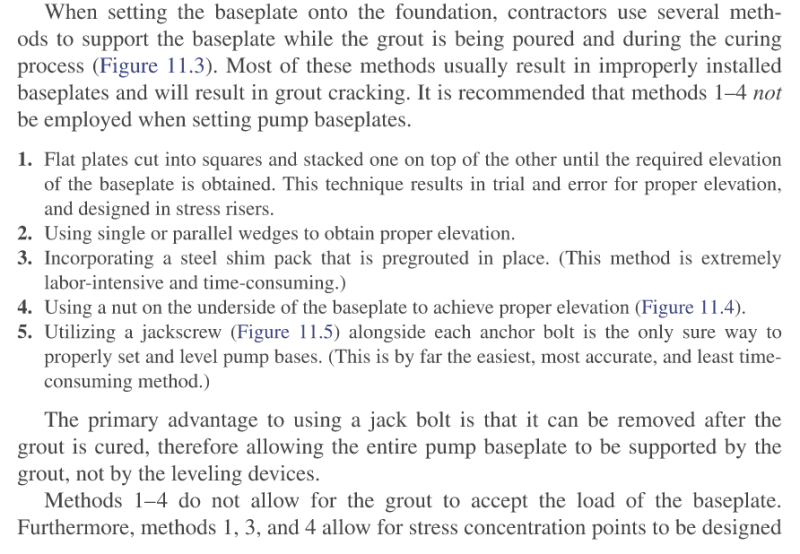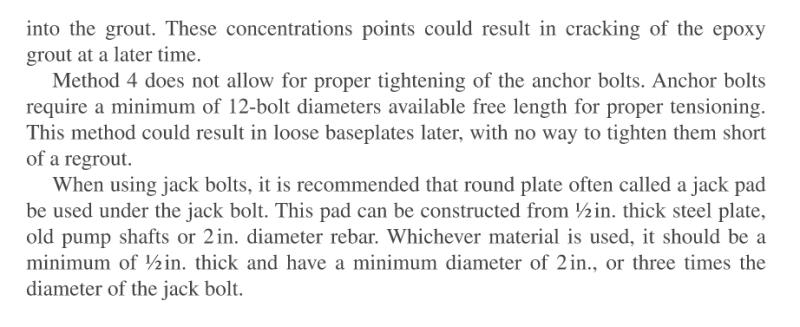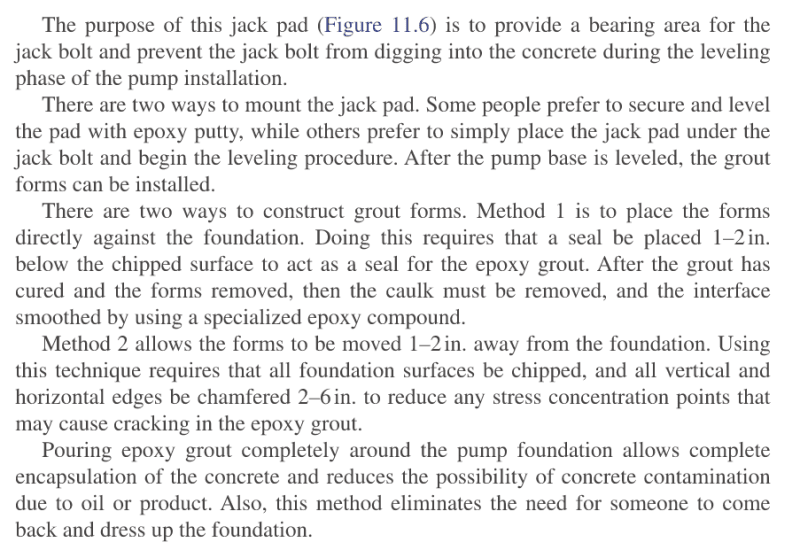I'm currently installing some pumps and plan to use leveling nuts to level the pumps. They are self aligning so that is not my concern. Before I pour the grout pad, I've been told I need to come off of the leveling nuts so that the nuts are not bearing all of the weight but instead the grout pad is. The question is how do I come off of the leveling nuts before the grout is poured? The only thing I can think of is make a form which covers all areas except where the nuts are. Pour this and let it cure. Then come off the leveling nuts and pour the remainder of the grout pad. Is there another way to do it?
Navigation
Install the app
How to install the app on iOS
Follow along with the video below to see how to install our site as a web app on your home screen.
Note: This feature may not be available in some browsers.
More options
Style variation
-
Congratulations MintJulep on being selected by the Eng-Tips community for having the most helpful posts in the forums last week. Way to Go!
You are using an out of date browser. It may not display this or other websites correctly.
You should upgrade or use an alternative browser.
You should upgrade or use an alternative browser.
Leveling nuts and shims with grout pads 7
- Thread starter nick24
- Start date
- Status
- Not open for further replies.
The jack pad just helps distribute the point load of the bolt to the concrete to avoid local crushing. If it is lightly loaded, it may not be super necessary. If it is heavily loaded, when they turn the bolt to level the equipment, the bolt will crush and indent into the concrete and may make it more difficult (maybe impossible?) to get it precisely leveled. I have seen these plates embedded in the concrete when it is poured and also where the person(s) setting the equipment just placed them loose under the bolt.
-
2
- #24
WARose said:Does anyone know the pros & cons of not providing the "jack-pad"?
Yes, to quote Harrison's book:



Thanks Ingenuity. I figured the stress of that bolt end would obviously be at issue.
While we are on the topic, does Mr. Harrison have any recommendations for epoxy-grouting techniques?
I did a thread on this not too long ago:
The problem I have typically been up against with this is complaints from the field on how cumbersome things can get. I got some good recommendations in that thread.....but am curious what Mr. Harrison thinks.
While we are on the topic, does Mr. Harrison have any recommendations for epoxy-grouting techniques?
I did a thread on this not too long ago:
The problem I have typically been up against with this is complaints from the field on how cumbersome things can get. I got some good recommendations in that thread.....but am curious what Mr. Harrison thinks.
WARose said:While we are on the topic, does Mr. Harrison have any recommendations for epoxy-grouting techniques?
He does indeed. His book (I have both 1st and 2nd Edition) is a 'soup to nuts' compendium. He compares cementitious and epoxy-based grouts, techniques, surface prep, mixing etc. He has entire chapters on each subject so it is a but difficult to detail them here.
Hi nick24,
What is "self aligning" ?
What is the pump OEM's recommendation for leveling? If they condone leveling nuts on the anchor bolts below the pump base be very afraid. Take measures to protect yourself.
When the OEM's fantasy land base design fails to perform during vibration acceptance tests You will be the one who looks bad, and will be expected to "fix" it for free.
Got some pictures of your pump bases from above and below, showing their construction and (I hope) welded reinforcement on the undersides, especially in the regions around the pump mounting bolts and leading to the anchor bolt locations?
Is the pump mounting surface machined flat? Is the pump base rolled from steel plate?
How thick?
Does the pump manufacturer offer a premium engineered base designed with a top plate at least 1/2" thick and strategically placed welded structural steel ribs to support the pump properly without relying on (you) filling it with magic grout?
There are some pump bases whose designs are 100% wishful thinking.
Expecting cementitious grout to "stick" to the underside of a steel plate is in my opinion beyond wishful thinking.
I believe you will find The intructions for epoxy grout detail surface prep similar to a real epoxy joint. Grit blasted to bare steel in "white" condition and degreased just prior to grouting.
Even then the expectation of a 100% void-free grout fill is asking A LOT.
.
Getting rid of those leveling nuts is the first step
What is "self aligning" ?
What is the pump OEM's recommendation for leveling? If they condone leveling nuts on the anchor bolts below the pump base be very afraid. Take measures to protect yourself.
When the OEM's fantasy land base design fails to perform during vibration acceptance tests You will be the one who looks bad, and will be expected to "fix" it for free.
Got some pictures of your pump bases from above and below, showing their construction and (I hope) welded reinforcement on the undersides, especially in the regions around the pump mounting bolts and leading to the anchor bolt locations?
Is the pump mounting surface machined flat? Is the pump base rolled from steel plate?
How thick?
Does the pump manufacturer offer a premium engineered base designed with a top plate at least 1/2" thick and strategically placed welded structural steel ribs to support the pump properly without relying on (you) filling it with magic grout?
There are some pump bases whose designs are 100% wishful thinking.
Expecting cementitious grout to "stick" to the underside of a steel plate is in my opinion beyond wishful thinking.
I believe you will find The intructions for epoxy grout detail surface prep similar to a real epoxy joint. Grit blasted to bare steel in "white" condition and degreased just prior to grouting.
Even then the expectation of a 100% void-free grout fill is asking A LOT.
.
Getting rid of those leveling nuts is the first step
Earlier this week, I found the following excerpt from a Flowserve manual (VERTICAL TURBINE PUMPS (VTPS) CENTRIFUGAL PUMPS ENGLISH 71569224 – 10-13). This manual was written for vertical turbine pumps, but imagine this provision applies to all pumps.
"If leveling nuts are used to level the base, they must be backed off as far as possible prior to grouting. Always shim near foundation bolts and then back off the leveling nuts. Now tighten the foundation bolts. If done otherwise there is a risk of significantly lowering the structural natural frequency that could result in separation of the base from the grout."
"If leveling nuts are used to level the base, they must be backed off as far as possible prior to grouting. Always shim near foundation bolts and then back off the leveling nuts. Now tighten the foundation bolts. If done otherwise there is a risk of significantly lowering the structural natural frequency that could result in separation of the base from the grout."
If leveling nuts are used to level the base, they must be backed off as far as possible prior to grouting. Always shim near foundation bolts and then back off the leveling nuts. Now tighten the foundation bolts. If done otherwise there is a risk of significantly lowering the structural natural frequency that could result in separation of the base from the grout.
Not sure I see the difference between just grouting after leveling (with the nuts) and the other approach as far as frequency goes. Usually the number of anchors are comparable to the number of jack screws.
WARose said:Not sure I see the difference between just grouting after leveling (with the nuts) and the other approach as far as frequency goes. Usually the number of anchors are comparable to the number of jack screws.
Yeah, the natural frequency remark from the Flowserve manual piqued my interest. Maybe there's a relationship between vibration and pre-load in an anchor rod. Intuitively, that makes sense to me; a tightened guitar string sustains better than a loose one. Or maybe the use of shims can mitigate grout creep.
I found a master's thesis on it. If I'm reading it right, pages 100 and 101 indicate that damping increases as preload decreases and vice versa.
Title: "Effect of Bolted Joint Preload on Structural Damping"
Author: Weiwei Xu
Link:
Yeah, the natural frequency remark from the Flowserve manual piqued my interest. Maybe there's a relationship between vibration and pre-load in an anchor rod. Intuitively, that makes sense to me; a tightened guitar string sustains better than a loose one. Or maybe the use of shims can mitigate grout creep.
I found a master's thesis on it. If I'm reading it right, pages 100 and 101 indicate that damping increases as preload decreases and vice versa.
Oh I don't doubt that preload will impact the dynamic characteristics.....but nothing should see preload before the grout hardens (and the shims would be gone).
Thanks for the paper (by the way).
racookpe1978
Nuclear
I've been working with bicycle wheel (and wheelchair heel) spoke tensions for a long while, but have not considered them like anchor bolt tension members. (Only as positioning tension members to move the wheel rim back and forth until aligned with the road and brakes.)
Turbine and turbine generator structural supports clearly are vibration-limited/vibration sensitive anchor bolts for grouting rules. But are the more flexible pipes connected to a vibrating load (fuel gas pipes, lube oil pipes, or bearing lift oil) pipe supports considered like pumps and equipment grouted mounts?
Turbine and turbine generator structural supports clearly are vibration-limited/vibration sensitive anchor bolts for grouting rules. But are the more flexible pipes connected to a vibrating load (fuel gas pipes, lube oil pipes, or bearing lift oil) pipe supports considered like pumps and equipment grouted mounts?
While we are on the topic of epoxy grouting.....does anyone have a strategy to avoid this situation? I've seen a few times in the field where the epoxy grout pulled away from the concrete (or the bottom of the skid). Fortunately, this hasn't happened to me yet....but I'd like to avoid it. Just eyeballing this stuff....it's predictably occurring well away from the preloaded anchors....and I think (putting aside possible bond issues for a moment) a decent amount of unbalanced force is responsible.
I also think part of the problem is the manufacturer's models of this. When I have seen their (static and dynamic) models of the skid.....the support points are only the preload anchor points. (Which won't be the case if the skid is epoxy grouted.) Once (when I was considering epoxy grout to a skid for a big compressor), I modeled the skid myself and with it continuously attached via epoxy. The unbalanced forces were a issue.
What to do when you suspect this? I've found that a lot of those manufacturers just green light doing this without knowing what is really going on.....and I don't feel responsible just putting on blinders and pretending the problem isn't (potentially) there just because they don't want to check it. I know they typically have some anchors at locations on the skid where there is stuff held down like motors, compressors and so on....but I've seen otherwise a few times.
I also think part of the problem is the manufacturer's models of this. When I have seen their (static and dynamic) models of the skid.....the support points are only the preload anchor points. (Which won't be the case if the skid is epoxy grouted.) Once (when I was considering epoxy grout to a skid for a big compressor), I modeled the skid myself and with it continuously attached via epoxy. The unbalanced forces were a issue.
What to do when you suspect this? I've found that a lot of those manufacturers just green light doing this without knowing what is really going on.....and I don't feel responsible just putting on blinders and pretending the problem isn't (potentially) there just because they don't want to check it. I know they typically have some anchors at locations on the skid where there is stuff held down like motors, compressors and so on....but I've seen otherwise a few times.
WARose said:Just wasn't sure if he recommended pressure grouting over some other technique.
Harrison's book only discusses pressure grouting (for epoxy) pertaining to epoxy injection of small voids under skids/baseplates detected after the baseplate grout has cured. I don't especially agree with his epoxy injection techniques using a 'grease gun' - I am used to using a 2-component positive displacement plural pump for pressure injection.
WARose said:does anyone have a strategy to avoid this situation? I've seen a few times in the field where the epoxy grout pulled away from the concrete (or the bottom of the skid). Fortunately, this hasn't happened to me yet....but I'd like to avoid it. Just eyeballing this stuff....it's predictably occurring well away from the preloaded anchors
So this is happening in the thickness of the epoxy - are they deep epoxy pours, like > 12"?
Sounds like resin shrinkage - incorrect ratio mixing, or not using all of the aggregate for 3-component blends?
Possibly thermal effects, due to the substrate temp or ambient temp, or possible exotherm during resin cure?
Is there resulting cracking in the epoxy (longitudinally) when this occurs?
So this is happening in the thickness of the epoxy - are they deep epoxy pours, like > 12"?
No. Much more shallow.
Sounds like resin shrinkage - incorrect ratio mixing, or not using all of the aggregate for 3-component blends?
Possibly thermal effects, due to the substrate temp or ambient temp, or possible exotherm during resin cure?
Is there resulting cracking in the epoxy (longitudinally) when this occurs?
I've seen it longitudinally a few times....but perpendicular in other cases. That's what gave rise to my unbalanced force theory. I've never gotten any epoxy grout manufacturer to say their product has a endurance limit for tensile stresses. (I suspect that (like concrete) it doesn't have one.)
- Status
- Not open for further replies.
Similar threads
- Question
- Replies
- 9
- Views
- 7K
- Locked
- Question
- Replies
- 4
- Views
- 473
- Locked
- Question
- Replies
- 4
- Views
- 1K
- Question
- Replies
- 5
- Views
- 8K
- Locked
- Question
- Replies
- 7
- Views
- 4K
